Does acrylic paint thrill you? Get started right away, don’t hold back your desires. Motivation is the first quality of thepainter, whether a beginner or a professional. To support you as you get started, here are 14 classic mistakes to avoid, for rapid, serene progress.
Copying the great masters
When you first start painting with acrylics, it’s not always easy to find your own inspiration. There’s so much you need to know acrylic painting ! What equipment is needed to use this type of paint? Should acrylic paint be thinned? Where to buy? These are the essential questions that keep running through your head, and that end up restricting your creative imagination. The energy invested in finding the right support, the right brushes, the right technique for mixing colors – all of this ends up getting the better of your inspiration: you finally have the ideal material, but now what do you paint?
It’s totally legitimate to want to turn to reproductions of paintings by the great masters, to boost your creativity. Why not take inspiration from it when you start out as a painter? This gives you a few ideas for mixes, themes that seem to strike a chord with you.
The mistake is to remain solely in the copying of masterpieces, and to become entrenched in a framework that is not your own. Quickly break this counter-productive pattern, which will only have the effect of blocking your imagination and repressing latent inspiration. Step out of your comfort zone of copying, and test your own creations for yourself.
It’s through trial and error, through your own personal development, that you’ll progress, from error to success, until your own artistic style emerges spontaneously. Inspiration isn’t always there, but it can be boosted in different ways.
Buying low-quality chassis
Even if you’re just starting out in acrylic painting, don’t try your hand at cheap canvases. Of course, this represents a budget, and looking for the best value for money is legitimate, especially when you’re not sure about your first brushstrokes: if I’m going to fail, I might as well do it on a cheap canvas!
First of all, there’s no such thing as failure in art: art is a personal emotion, transcribed onto a medium. Instead, we’re talking about errors in paint use, such as undiluted or over-thinned paint, or unsatisfactory mixes.
Low-quality sashes, usually made of cotton, react to ambient temperature: your creation will live and breathe with heat and humidity, yo-yoing as it stretches or relaxes. The cheap canvas warps, the frame twists: the result will be catastrophic and will disappoint and frustrate you.
Even beginner painters should opt for quality, for a real apprenticeship in acrylic painting techniques.
A deformed canvas will also be unsaleable…
In my case, I’ve decided to opt for quality and now produce all my paintings on Master Toile stretchers and canvases.
Acquire acrylic paint 1st prize
Just like buying low-end frames, acrylic paint of unknown origin and with no brand name is no guarantee of quality.
Using cheap tubes of paint gives an unsightly rendering, with colors that lack opacity, which is likely to disappoint you and make you lose your motivation to paint.
If you’re an artist with painting skills, you’ll need equipment to match your budding expertise.
Unbranded acrylic paint cracks as it dries, often giving off a suspicious or even toxic odour…
The Daler Rowney, Pébéo or Liquitex brands offer quality products at affordable prices, for working in good conditions.
In my case: I use super-fine paint: System 3 by Daler Rowney
Forget your brushes full of paint
After a painting session, tidying up and cleaning the tools used is not the most pleasant part. However, a brush, spalter, roller or even a knife with dried paint will be difficult, if not impossible, to save.
At best, you’ll end up with tools of degraded quality, at worst, you’ll lose your equipment (which comes at a cost).
It’s so easy to anticipate the irreversible drying of acrylic paint (which dries very quickly) on your brushes: place containers filled with water on your work surface, into which you place your tools as you work.
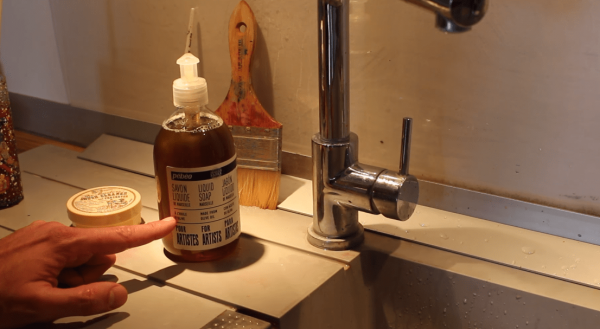
I recommend that you read my article on brush cleaning
Neglecting the worktop
Identify a specific place to paint. Acrylic painting requires you to bring out lots of tools: tubes of paint of all kinds (and their caps!), thinners, molding paste, rollers, rags, objects of all kinds, containers of water, the palette, you name it.
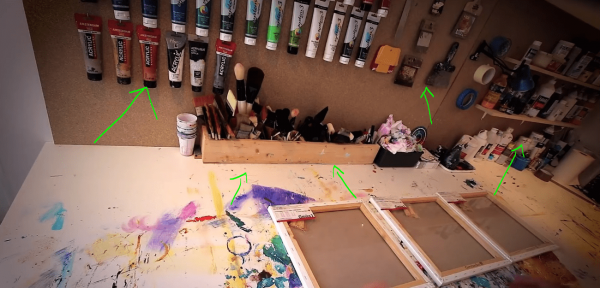
Before you know it, you’re overrun!
Two risks:
- not being able to find your way around and desperately searching for a tube or brush you can’t find in the clutter on your worktop, wasting a lot of time: acrylic paint sets very quickly!
- make an unfortunate gesture and grab the brush over there, behind the glass of water between the open tubes… and ruin all your work in 1 second by dropping something on it.
Treat yourself to an organized space: bins identified and arranged within easy reach, wall-mounted pins for hanging tools, racks for sorting your tubes of color and various thinning agents.
Expressing yourself in paint is all the more pleasant and easier in a healthy, serene environment!
Too much acrylic paint: stop wasting it!
With regular practice, you’ll find the ideal way to manage the quantities of paint to be placed on the palette.
Start by using small touches to get used to the texture of the products, their ease of stretching and covering the canvas, and the quantities needed when mixing colors.
Remember that acrylic paint is used diluted with water, so don’t use too much!
Giving in to impatience to become a renowned painter
One thing’s for sure: you’re going to make progress and acquire all the acrylic painting techniques you need, so be patient and don’t rush things.
Take the time
- Familiarize yourself with the texture and consistency of acrylics, and the reaction of substrates to their application;
- develop confidence and precision in your movements.
Overlooking communication
To develop as aprofessional painter, it’s essential to showcase your talent and your work.
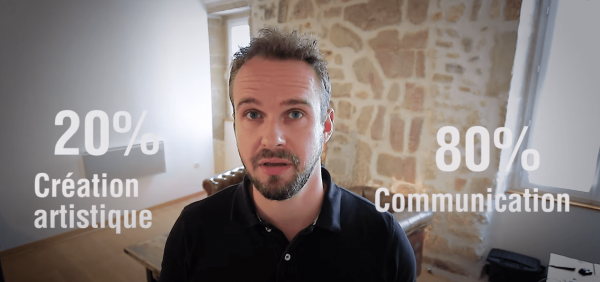
Try to break through by taking part in exhibitions and competitions. Show off your paintings! Create a network of people with a genuine interest in acrylic and abstract painting.
Being naive and accepting dishonest offers
Be on the lookout for suspicious offers on the Internet, or fraudulent e-mails that blind you to the prospect of success in a short space of time… in exchange for the few small digits on your bank card. Beware of group orders suddenly arriving from abroad, from sites or organizations with no reputation, and who only want to pay via paypal…
Don’t worry: you’ll make it in the painting world, whatever your plans for your artistic career, without having to sell yourself.

Your productions will be recognized for their true worth, by people worthy of your talent.
Selling undeclared: URSSAF hot on your trail
Two clear reasons to declare your activity and sales:
- be legal and respect the principles of trade ;
- feel recognized as aprofessional painter and assert your rights!
Be open to criticism
Praise for your paintings is easy to receive, but what about negative criticism?
The term “review” is generally always interpreted in a negative light. Criticism, however, can be positive, when it takes on the meaning of “interpretation”.
There are two possible scenarios:
- purely negative criticism aimed at harming and injuring others: you may have to deal with the “haters“These people, who are so unhappy, find daily pleasure and meaning in their existence only in the harm they cause through their unkind and unfounded remarks. With these, don’t waste your precious time in justifications or various explanations: ignore, or answer with humor;
- positive criticism from experienced painters: jump at the chance to learn more about their talent, open your ears wide and take in all the kind, constructive remarks they make!
Showing your work: how to overcome your fears
Human beings are rarely fully satisfied with their work. Be proud of your paintings: they’re yours, with your own unique touch.
Art is subjective, and you can’t call a painting a success or a failure: on the other hand, you can dislike the style, the colors used, the shapes and motifs, but that in no way detracts from its quality and value.
Forget impostor syndrome: you have every right to display your compositions to the general public!
Showing your work gives you the chance to get feedback from your viewers.
The danger of social networking
The Internet is a tool of choice that has become an indispensable part of our daily lives.
As mentioned above, you’ll be presenting your paintings on various platforms and social networks: the more visibility you gain, the more likely you are to receive (negative) comments.
Don’t play the game of replying to negative comments, just take note of them and move on!

The comments are often ultra-violent, destructive and, above all, unfounded. Don’t dwell on it.
Knowing how to say… no!
Your creations are unique, the fruit of YOUR inspiration: you chose your colors, imagined your gradations… Your imagination and the way it’s put on canvas are your own.
You meet a potential customer, but he’d prefer a more opaque gradient, a lighter background color, on a different format, and with a knife, not a brush, and more blue and less red, and with more sparkle in the left corner, and…
In short, it’s not the painting of his dreams: in short, he’s asking you to remake it to suit his tastes.
At the start of a career, in order not to frustrate potential buyers, it’s tempting to repeat this famous table with the prospect’s wishes, to satisfy them and eventually “sell”.
So you’re forcing your creativity to respond to an order that doesn’t suit you: in fact, if it did, you’d have painted it by now!
Say no: you have the right to refuse custom-made paintings.
Kindly invite these interested people to visit your site, and see if one of your paintings is closer to their desires, or to wait for your next creations.
Paintings are not made to order; they are the fruit of YOUR unique and personal inspiration.
Example

Please leave a comment
Did you like this article? I’d be delighted to hear from you below.
Pack offert : Techniques, matériel & guide
Pour vous lancer dans la peinture abstraite dans de bonnes conditions, je vous offre ce pack comprenant mon guide du matériel, un cours de peinture abstraite et une avalanche de conseils !
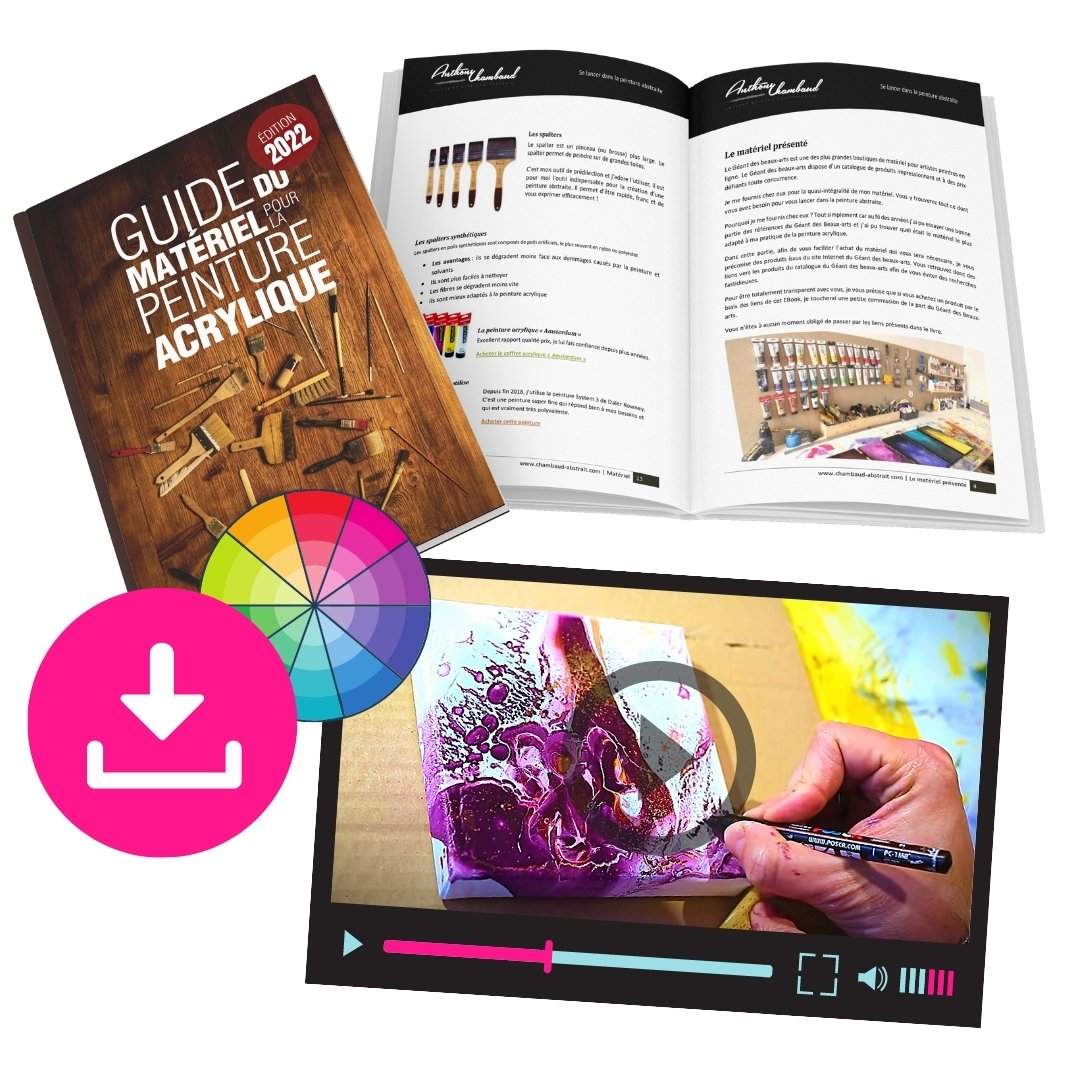
Continuer et télécharger






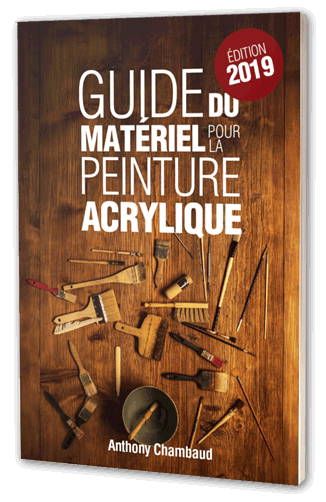


 Recevez votre Pack du peintre débutant
Recevez votre Pack du peintre débutant